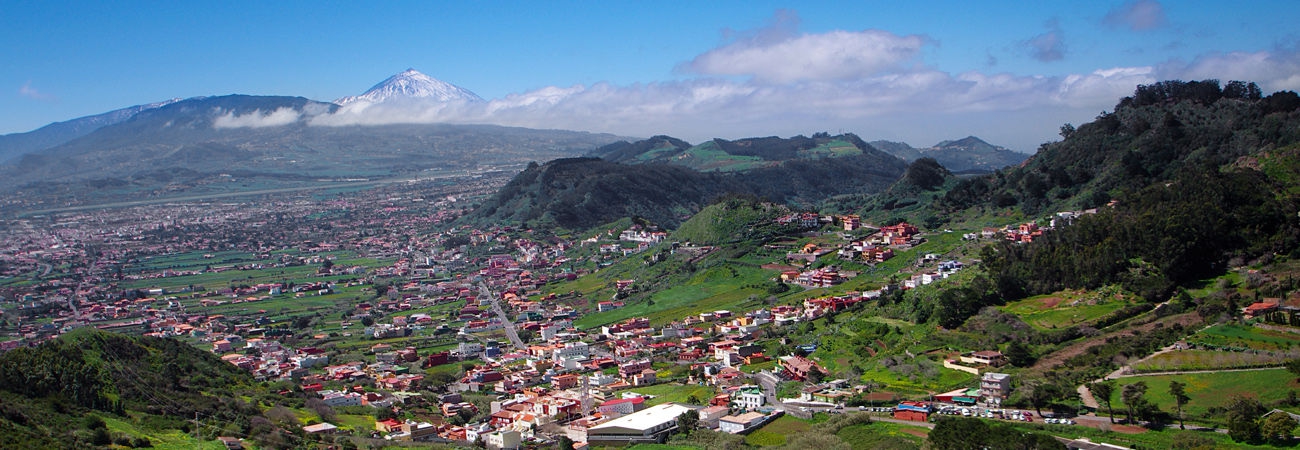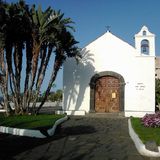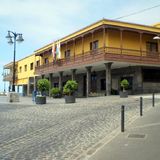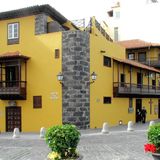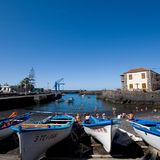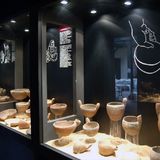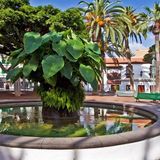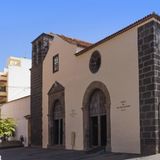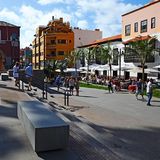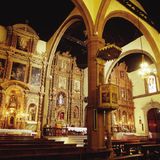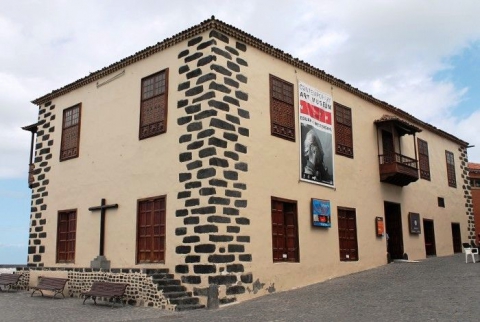Puerto de la Cruz
CULTURAL-HISTORIC ROUTE
The route starts in PLAZA VIERA Y CLAVIJO, opposite the old Martianez Hotel, as this is where tourism first started in Puerto de la Cruz in 1866, when the Orotava Grand Hotel was opened as a Sanatorium on the Martianez flats. As we walk down the PASEO AGUILAR Y QUESADA, commonly known as the paseo de las palmeras, we can see the Martianez cliffs on the right, which contain important archaeological remains of the Guanches, the original inhabitants of the island. This takes us right down to the coast, where we can enjoy the beach of the same name. Almost immediately, we come to PLAYA DE MARTIANEZ, a black-sand beach, like all the others in the north, which is the setting for the "COSTA MARTIANEZ" MUNICIPAL TOURIST COMPLEX. This is a complex of swimming pools and a large artificial lake, the work of Cesar Manrique from Lanzarote, that is one of the most important leisure assets on the island.
CHURCH OF SAN TELMO
The Avenida de Colon takes us as far as the PLAZA DE LOS REYES CATOLICOS; a few metres away, we can see the CHURCH OF SAN TELMO, founded in 1780 by the Guild of Merchants. It is devoted to the Dominican Friar San Pedro Gonzalez Telmo, the Patron Saint of sailors. The figure of the saint that is currently kept in the church dates from the late XVIII century. This is carried around the town in procession, along with the Virgen del Carmen, in the main fiestas of Puerto de la Cruz, held in July.
Continuing with our walk, we come to the PLAYA DE SAN TELMO, a small jetty surrounded by natural pools, that goes back a long way in local tradition. At the end is the PUNTA DEL VIENTO LOOK OUT, overlooked by Spectator, a sculpture by local artist Arnoldo Evora.
Calle Santo Domingo will take us from here to what used to be a Dominican convent and is the birthplace of Luis Rodriguez Figueroa, a famous politician and writer.
CITY HALL and Plaza de Europa
This street will take us to the CITY HALL, which was last refurbished in 1973. On the façade, we can see the city coat of arms designed by Monsignor Bruno Heim: In the centre, the red-tongued, green dragon, the mythical guardian of the Garden of the Heperides, beyond the pillars of Hercules, the Eden of the three Golden Nymphs: over its back, the red Latin cross, the cross of the Port contemplating its name and its traditions; Under its claws is a blue field with three undulating strips of silver, the deep sea-faring roots of the city as a means of trade and expansion; superimposed, the sabre key that opens the way to the Indies route; impressed, the crown reflecting the monarchy of the Catholic Kings.
We can look over to the PLAZA DE EUROPA, a genuine architectural monument in the form of a fortress overlooking the sea, with its bust in honour of one of the founding fathers of the independence of the Republic of Venezuela, Francisco de Miranda, the relative of a local inhabitant who was forced to emigrate to the Americas in the XVIII century. The palisade that crowns the walls is adorned with six cannons from the XVIII and XIX centuries, donated by the Ministry of Defence and the Canary Islands Military Command. The square has been named in recognition of the city´s traditional European leanings.
Casa de Miranda
The CASA DE MIRANDA on one side of the square gives way to Las Lonjas, a pedestrian street that is one of the most picturesque spots of the city, where we can still see the cobbles that covered the whole town in times gone by. There are also some fine examples of Canary Island architecture in this area.
THE ROYAL CUSTOMS HOUSE
If we follow this route, we come to the ROYAL CUSTOMS HOUSE, founded in 1620 and rented by the Real Hacienda, or Royal Treasury to house the customs offices and as the residence for the administrators up until 1833, when it was moved to Santa Cruz de Tenerife. Next to the customs house is the Santa Barbara battery, where you can still see the remains of the ladder leading down to the sea (built in 1741). The battery used to be armed with four cannons to defend the ships that moored in Limpio de Las Carabelas, near the point of the old dock.
In the XVII and XVIII centuries, this harbour was vital for the whole island. 80% of all Canary Island exports were shipped out of what at the time was known as Puerto de La Orotava, which is why King Phillip IV awarded the town the title of The Key to the Island in 1648.
The TOURIST BOARD OFFICES are also located here. In April 2008, at the proposal of the Lions' Club, a monument to the fishwife by sculptor Julio Nieto was officially uncovered alongside the fishing quay.
ARCHAEOLOGICAL MUSEUM
Walking around the beached boats of the fishing harbour, we enter the popular fisherman´s district of La Ranilla and the ARCHAEOLOGICAL MUSEUM, housed in a XIX century Canary Island mansion. The museum was opened in 1991, although its origins date back to 1953, when the Canary Island Institute of Hispanic Studies created its Archaeological Museum. The works include an interesting collection of aboriginal pottery and other valuable utensils, mummified Guanche remains, XVII century maps, etc. From time to time, they organise thematic exhibitions on different aspects of the history and culture of the Canary Islands.
Going up Calle Perez Zamora, we can make out the first buildings that were put up for the tourist industry. What is now the "Casa del Pueblo" (the former Royal Hotel) is one of these. A little further up on the left, Calle Jose de Arroyo is where we can find the statue of a leading local painter, FRANCISCO BONNIN, whose water colours were praised and admired by Cuban poetess Dulce Maria Loynaz, winner of the Cervantes prize in 1992 and favourite daughter of Puerto de la Cruz.
PLAZA DEL CHARCO
At the end of the street, we come to PLAZA DEL CHARCO, whose exact date of construction is unknown as there has always been an open space and meeting place on the site. Plaza del Charco (Pond Square) is so called because a pool of sea water used to form there when the tides were high. The square has recently been refurbished, although it still retains its most important features like the fountain with the yam tree, its Indian laurels and palm trees, the volcanic cinder beds in the middle of the square and the path around the edge.
We now continue along the east side of the square and on into Calle Blanco (the Spanish version of Nicholas White, the first Irish mayor of the town in the late XVIII century), where we can see some fine examples of Canary Island houses. One of the most significant is the birthplace of Jose Agustin Alvarez Rixo (1796-1883), the famous historian, writer and mayor of Puerto de la Cruz.
THE CHURCH OF SAN FRANCISCO
When we turn the corner into Calle Valois, we come across the elegant figure of the VENTOSO TOWER, which forms part of one of the city´s best conserved XVIII century quarters and a clear reminder of the splendour of XVIII century Puerto de la Cruz. The tower is one of the few survivors of its kind; it is a building in its own right and one of the most elegant examples of local island architecture.
A few metres further on, after crossing Calle Las Damas, we come to PLAZA CONCEJIL, where two pedestrian streets cross. A monument has been erected in the square, to Francisco Afonso Carrillo, the former mayor of Puerto de la Cruz and Civil Governor of the province. The monument is directly opposite the house where the Iriarte brothers were born (leading figures of Spanish illustration).
Almost at the end of Calle San Juan, we find the CHURCH OF SAN FRANCISCO AND SAN JUAN, built in 1599, making it the oldest building in Puerto de la Cruz. It is now an ecumenical church that is used by all the different foreign Christian communities who have settled in Puerto de la Cruz. Its valuable heritage includes works of different styles that date from the XV century, up to modern times.
CALLE QUINTANA
If we continue along Calle Quintana, we come to the Canary Island Institute of Spanish Studies, a cultural centre used for holding conferences, exhibitions and Spanish courses for foreigners. The centre has a library that is open to the public in the afternoons. A few metres away, on the other side of the street, is the birth place of Luis de la Cruz y Rios, painter of the court of King Fernando VII.
Further along the same street, we can see the HOTEL MARQUESA, one of the first buildings to be used for housing tourists. At the end of the XVIII century, it provided accommodation for the famous German naturalist, Alexander von Humboldt, on his way to the Americas.
The Church of La Peña de Francia
Leaving the hotel behind us, we come to a square and the CHURCH OF NUESTRA SEÑORA DE LA PEÑA DE FRANCIA. The figure of this Virgin, the Patron Saint of the city, presides over the main altar. Around 1620, the local residents felt they needed to convert the small hermitage founded by Governor Franchy Luzardo, into a church. Work started in 1684. The tower was added later (1898). The church contains an important artistic legacy that includes the figure of the Señor del Gran Poder de Dios (XVII-XVIII century) and the paintings of the altar and the pulpit, which were the work of local painters Luis de la Cruz y Rios and Manuel de la Cruz respectively. The importance of the Irish families that settled in Puerto de la Cruz can be clearly seen in the chapel of Saint Patrick of the Emerald Isle, which is kept inside the church.
On the north side of the square is a bust in memory of a leading son of Puerto de la Cruz, Agustin de Betancourt y Molina (1758-1824), a local engineer who reached the rank of General in the Russian army of Tsar Alexander I. He was the first director of the Madrid School of Civil Engineering. The Hotel Monopol , opposite the bust, is built on the site of his birthplace.







